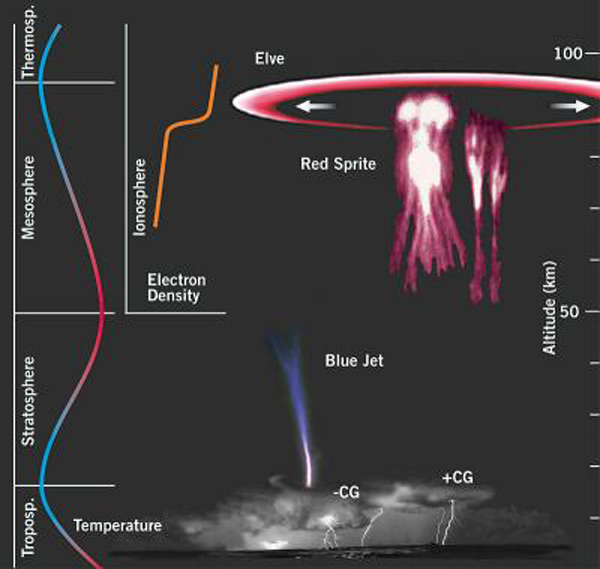
Elves and Sprites Caught Dancing Near the Edge of Space

Spectacular light shows shooting out of the tops of storms clouds have been reported by pilots for decades. At first, scientists didn't believe what the pilots claimed to be seeing. Now the strange colored lights have been captured on high-speed video.
The fleeting, brilliant electric phenomena are known as elves and sprites. These electric displays are produced in the upper layers of the atmosphere. They've been photographed and videotaped before, but in the new research, they have been captured in a variety of forms that will allow the researchers to study the structure and dynamics of these strange electric discharges.
"This is the first time in Europe that we have been able to use high-speed video to detect transitory luminous phenomena taking place in the upper atmosphere — so-called sprites [in the form of a carrot or column] and elves [which are ring shaped]," said study co-author Joan Montanyà of the Polytechnic University of Catalonia (UPC) in Spain.
Sprites are jellyfish-shaped emissions that occur above thunderstorms. These and other lightning-related phenomena — like blue jets and elves — are called transient luminous events (TLEs).
Sprites, also called red sprites, frequently occur in clusters of three or more. They soar up to 59 miles (95 kilometers) into the atmosphere, above thunderstorms. Their flash is incredibly brief — just 3 to 10 thousandths of a second long. The flashes expand to cover a wide area but are weak in electrical energy. Their brightest portions exist 40 to 45 miles (65 to 75 kilometers) up, above which wisps and glowing regions often extend.
Occurring at about the same time as red sprites are elves, a pancake-shaped red glow created by the heat of conventional lightning below. These flashes last only thousandths of a second, and scientists are still investigating exactly what causes them.
Blue jets — cousins to red sprites — are cones of bluish light that occur lower in the atmosphere than red sprites.
Sign up for the Live Science daily newsletter now
Get the world’s most fascinating discoveries delivered straight to your inbox.
As it is difficult to record these phenomena inside a storm while they're happening, the researchers placed a high-speed video camera on land with an image intensifier. This was used to remotely record a winter storm in the Western Mediterranean at a distance of between 250 and 620 miles (400 and 1,000 kilometers) away from the recorder between the coasts of Italy and Spain.
The high-speed video shows that there are many fewer elves in storms that form over land than those at sea, where electric currents apparently have greater energy, especially in winter. Some of the recordings show elves and sprites at the same time, evidence of the strength of lightning over the sea during winter storms.
The scientists also observed the interaction between two sprites. A branch of one of them hit and bounced off the second, giving clues about their dynamics and electric structure.
The study is detailed in a recent edition of the Journal of Geophysical Research.









